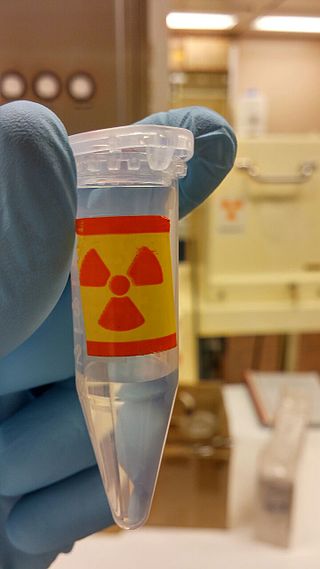Related Research Articles

Positron emission tomography (PET) is a functional imaging technique that uses radioactive substances known as radiotracers to visualize and measure changes in metabolic processes, and in other physiological activities including blood flow, regional chemical composition, and absorption. Different tracers are used for various imaging purposes, depending on the target process within the body. For example, 18
F
-FDG is commonly used to detect cancer, NaF18
F
is widely used for detecting bone formation, and oxygen-15 is sometimes used to measure blood flow.

Nuclear medicine or nucleology is a medical specialty involving the application of radioactive substances in the diagnosis and treatment of disease. Nuclear imaging, in a sense, is "radiology done inside out" because it records radiation emitting from within the body rather than radiation that is generated by external sources like X-rays. In addition, nuclear medicine scans differ from radiology, as the emphasis is not on imaging anatomy, but on the function. For such reason, it is called a physiological imaging modality. Single photon emission computed tomography (SPECT) and positron emission tomography (PET) scans are the two most common imaging modalities in nuclear medicine.

[18F]Fluorodeoxyglucose (INN), or fluorodeoxyglucose F 18, also commonly called fluorodeoxyglucose and abbreviated [18F]FDG, 2-[18F]FDG or FDG, is a radiopharmaceutical, specifically a radiotracer, used in the medical imaging modality positron emission tomography (PET). Chemically, it is 2-deoxy-2-[18F]fluoro-D-glucose, a glucose analog, with the positron-emitting radionuclide fluorine-18 substituted for the normal hydroxyl group at the C-2 position in the glucose molecule.

Nuclear pharmacy, also known as radiopharmacy, involves preparation of radioactive materials for patient administration that will be used to diagnose and treat specific diseases in nuclear medicine. It generally involves the practice of combining a radionuclide tracer with a pharmaceutical component that determines the biological localization in the patient. Radiopharmaceuticals are generally not designed to have a therapeutic effect themselves, but there is a risk to staff from radiation exposure and to patients from possible contamination in production. Due to these intersecting risks, nuclear pharmacy is a heavily regulated field. The majority of diagnostic nuclear medicine investigations are performed using technetium-99m.

Fluoroiodomethane is the halomethane with the formula FCH2I. Also classified as a fluoroiodocarbon (FIC), it is a colorless liquid. It is a reagent for the introduction of the fluoromethyl (FCH2) group.

EF5 is a nitroimidazole derivative used in oncology research. Due to its similarity in chemical structure to etanidazole, EF5 binds in cells displaying hypoxia.
Copper-64 (64Cu) is a positron and beta emitting isotope of copper, with applications for molecular radiotherapy and positron emission tomography. Its unusually long half-life (12.7-hours) for a positron-emitting isotope makes it increasingly useful when attached to various ligands, for PET and PET-CT scanning.

Altropane is a phenyltropane derivative which acts as a potent dopamine reuptake inhibitor and long-acting stimulant drug. It has mainly been used as the 125I radiolabelled form for mapping the distribution of dopamine transporters in the brain, and consequently this has led to its development as a potential diagnostic tool for early detection of Parkinson's disease. It is also being investigated for potential use in the diagnosis and treatment of attention deficit hyperactivity disorder (ADHD).

Brain positron emission tomography is a form of positron emission tomography (PET) that is used to measure brain metabolism and the distribution of exogenous radiolabeled chemical agents throughout the brain. PET measures emissions from radioactively labeled metabolically active chemicals that have been injected into the bloodstream. The emission data from brain PET are computer-processed to produce multi-dimensional images of the distribution of the chemicals throughout the brain.

Mefway is a serotonin 5-HT1A receptor antagonist used in medical research, usually in the form of mefway (18F) as a positron emission tomography (PET) radiotracer.

Iomazenil is an antagonist and partial inverse agonist of benzodiazepine and a potential treatment for alcohol use disorder. The compound was introduced in 1989 by pharmaceutical company Hoffmann-La Roche as an Iodine-123-labelled SPECT tracer for imaging benzodiazepine receptors in the brain. Iomazenil is an analogue of flumazenil (Ro15-1788).

Nifene is a high affinity, selective nicotinic α4β2* receptor partial agonist used in medical research for nicotinic acetylcholine receptors, usually in the form of nifene (18F) as a positron emission tomography (PET) radiotracer.

Desmethoxyfallypride is a moderate affinity dopamine D2 receptor/D3 receptor antagonist used in medical research, usually in the form of the radiopharmaceuticals desmethoxyfallypride or DMFP(18F) and has been used in human studies as a positron emission tomography (PET) radiotracer.

18F-FMISO or fluoromisonidazole is a radiopharmaceutical used for PET imaging of hypoxia. It consists of a 2-nitroimidazole molecule labelled with the positron-emitter fluorine-18.

Dihydrotetrabenazine or DTBZ is an organic compound with the chemical formula C19H29NO3. It is a close analog of tetrabenazine. DTBZ and its derivatives, when labeled with positron emitting isotopes such as carbon-11 and fluorine-18, are used as PET radioligands for examining VMAT2.
Philip F. Cohen is a Canadian clinical director of Nuclear Medicine working out of the Lions Gate Hospital in North Vancouver, British Columbia. As a nuclear medicine physician, he is a pioneer in the usage of 3-D imaging techniques to improve diagnosis of bone disease and injury in collaboration with the Medical Imaging Research Group at University of British Columbia. Furthermore, Cohen has been involved in clinical research trials of new radiopharmaceuticals. To that effect, Cohen was the first recipient of a research grant from the Lions Gate Hospital Foundation, one of several peer-reviewed awards that would follow.

Peter J. H. Scott FRSC CChem is a British and American chemist and radiochemist who is an Associate Professor of Radiology and Pharmacology, as well as a Faculty Scientist in the Interdepartmental Program in Medicinal Chemistry and a Core Member of the Rogel Cancer Center at the University of Michigan in the United States. He is Chief of Nuclear Medicine and Director of the University of Michigan Positron Emission Tomography (PET) Center, and runs a research group developing new radiochemistry methodology and novel PET radiotracers.
Jason S. Lewis is a British radiochemist whose work relates to oncologic therapy and diagnosis. His research focus is a molecular imaging-based program focused on radiopharmaceutical development as well as the study of multimodality small- and biomolecule-based agents and their clinical translation. He has worked on the development of small molecules as well as radiolabeled peptides and antibodies probing the overexpression of receptors and antigens on tumors.

Flortaucipir (18F), sold under the brand name Tauvid, is a radioactive diagnostic agent indicated for use with positron emission tomography (PET) imaging to image the brain.
Hartmuth Christian Kolb is a German chemist. He is considered one of the founders of click chemistry.
References
- 1 2 "Neil Vasdev". Canada Research Chairs. Government of Canada.
- 1 2 "Dr. Neil Vasdev". CAMH.
- 1 2 "Veterans and mental illness — How Canadian research could unlock the mysteries of the brain - National | Globalnews.ca". Global News. Retrieved 2022-11-14.
- 1 2 Petracek, Heidi (Jan 13, 2023). "Researchers investigating head trauma in the Canadian military want veterans to 'pledge their brain'". CTV News. Retrieved Jan 16, 2023.
- ↑ Kounang, Nadia (2019-04-10). "A study of NFL players' brains might help diagnose CTE in the living". CNN. Retrieved 2023-02-24.
- 1 2 Belson, Ken (November 17, 2022). "A Test for C.T.E. in the Living May Be Closer Than Ever". The New York Times. Retrieved November 17, 2022.
- ↑ "'The human brain is the final frontier.' $15M gift from Garron family a boost for CAMH's brain imaging centre". thestar.com. 2020-11-03. Retrieved 2023-02-24.
- ↑ "Oakville native recruited to head new mental health research centre". InsideHalton.com.
- ↑ "Neil Vasdev". psychiatry.utoronto.ca.
- ↑ "Society of Nuclear Medicine and Molecular Imaging Announces 2021 Fellows – SNMMI". www.snmmi.org.
- ↑ "American Chemical Society names ACS Fellows for 2020". American Chemical Society.
- ↑ Hansraj, Benita (6 November 2017). "CAMH builds on radioimaging legacy with creation of the Azrieli Centre for Neuro-Radiochemistry".
- ↑ "KPE experts among U of T researchers sharing $9 million in new funding | UofT – Faculty of Kinesiology & Physical Education". kpe.utoronto.ca.
- ↑ Stephenson, Nickeisha A.; Holland, Jason P.; Kassenbrock, Alina; Yokell, Daniel L.; Livni, Eli; Liang, Steven H.; Vasdev, Neil (1 March 2015). "Iodonium Ylide–Mediated Radiofluorination of 18F-FPEB and Validation for Human Use". Journal of Nuclear Medicine. 56 (3): 489–492. doi:10.2967/jnumed.114.151332. PMC 4878451 . PMID 25655630 – via jnm.snmjournals.org.
- ↑ Rotstein, Benjamin H.; Liang, Steven H.; Holland, Jason P.; Collier, Thomas Lee; Hooker, Jacob M.; Wilson, Alan A.; Vasdev, Neil (28 May 2013). "11CO2 fixation: a renaissance in PET radiochemistry". Chemical Communications. 49 (50): 5621–5629. doi:10.1039/C3CC42236D. PMC 5604310 . PMID 23673726.
- ↑ Varlow, Cassis; Vasdev, Neil (2022-09-01). "Evaluation of Tau Radiotracers in Chronic Traumatic Encephalopathy". Journal of Nuclear Medicine: jnumed.122.264404. doi:10.2967/jnumed.122.264404. ISSN 0161-5505. PMID 36109185. S2CID 252309243.
- ↑ Narayanaswami, Vidya; Dahl, Kenneth; Bernard-Gauthier, Vadim; Josephson, Lee; Cumming, Paul; Vasdev, Neil (1 January 2018). "Emerging PET Radiotracers and Targets for Imaging of Neuroinflammation in Neurodegenerative Diseases: Outlook Beyond TSPO". Molecular Imaging. 17: 153601211879231. doi:10.1177/1536012118792317. PMC 6134492 . PMID 30203712.
- ↑ "Project Enlist researching military veterans' brains to study CTE | Watch News Videos Online". Global News. Retrieved 2022-11-11.